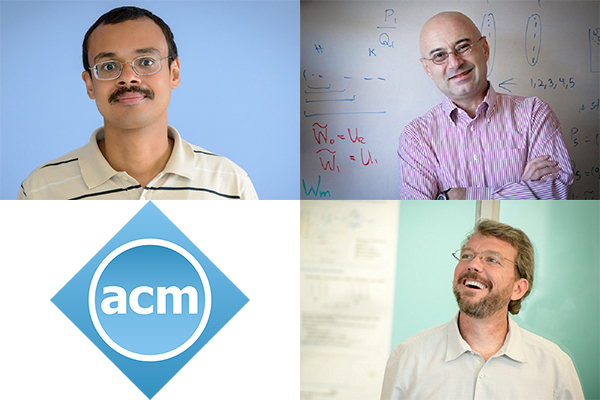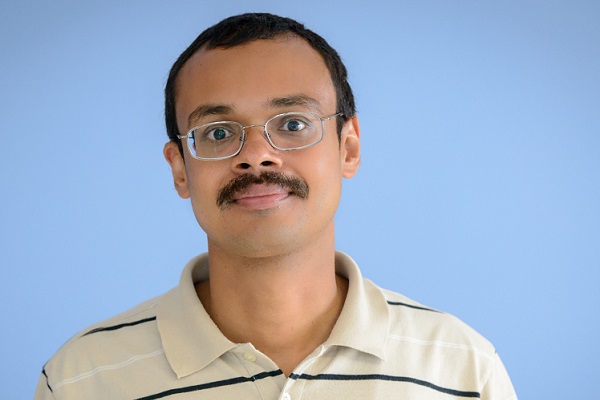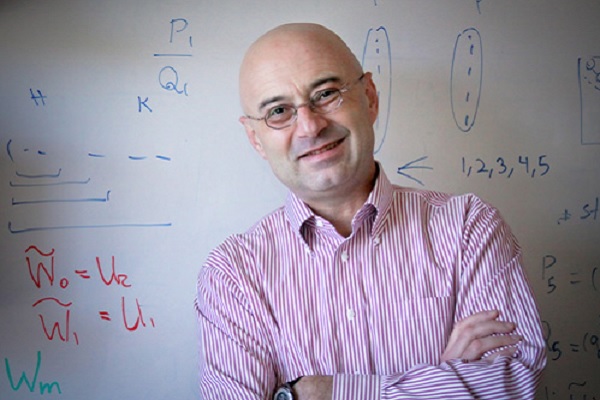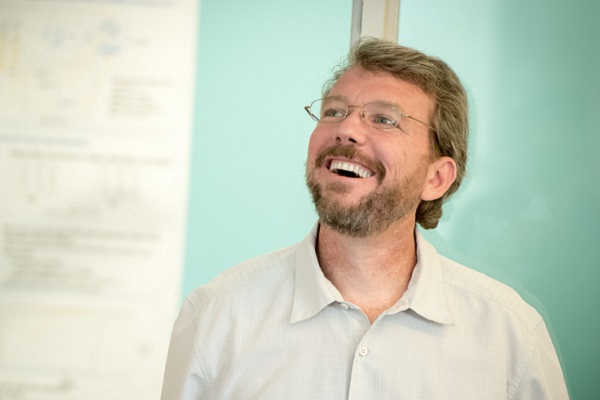Three UC San Diego Computer Scientists Elevated to Be ACM Fellows in Class of 2017
Three computer scientists from the Jacobs School of Engineering at the University of California San Diego have been elected Fellows of the Association for Computing Machinery (ACM). All three are also academic participants in the Qualcomm Institute. ACM is the world’s largest educational and scientific computing society.

In announcing its Class of 2017 Fellows, ACM cited:
- Computer Science and Engineering (CSE) professor Ravi Ramamoorthi for his “contributions to computer graphics rendering and physics-based computer vision”;
- CSE professor Alexander Vardy, whose main faculty appointment is in Electrical and Computer Engineering (ECE), was cited for his “contributions to the theory and practice of error-correcting codes and their study in complexity theory”; and
- CSE professor Geoffrey M. Voelker was honored for “contributions to empirical measurement and analysis in systems, networking and security.”
“Professors Ramamoorthi, Vardy and Voelker have all been pioneers in their respective fields of graphics and vision, computer systems and networking, and information and coding theory,” said CSE chair Dean Tullsen. “They all richly deserve the honor of being elected by their peers to be Fellows of the ACM.”
The addition of Ramamoorthi, Vardy, and Voelker brings to 11 the number of ACM Fellows among active faculty in the CSE department. Prior honorees included Victor Vianu (2006), Pavel Pevzner (2010), Stefan Savage (2010), Dean Tullsen (2011), Andrew Kahng (2012), Yuanyuan Zhou (2013), Mihir Bellare (2013), and Rajesh Gupta (2016). Ramamoorthi – who became an IEEE Fellow at the beginning of the year – and Vardy – who became an IEEE Fellow in 1999 – are now two of only six CSE faculty to be Fellows of both ACM and IEEE. The others are professors Kahng, Tullsen, Zhou and Gupta.
Elected ACM Fellows represent the top 1% of ACM members for outstanding accomplishments in computing and information technology. The induction of new ACM Fellows will take place on Saturday, June 23, 2018 in San Francisco at the annual ACM Awards Banquet.
Ravi Ramamoorthi
With 64 papers in ACM SIGGRAPH and the ACM Transactions on Graphics, Ramamoorthi is widely acknowledged as the leading researcher in rendering (one of the four main areas of computer graphics). He has published more than 140 papers to date in computer graphics and computer vision.
As early as 2007, Ramamoorthi received the ACM SIGGRAPH Significant New Researcher Award for his “groundbreaking work on the mathematical representations and computational models for the visual appearance of objects." One year later, at the White House, he was awarded a Presidential Early Career Award for Scientists and Engineers (PECASE) for his work in physics-based computer vision.

Among other honors, Ramamoorthi has received an NSF CAREER Award and Sloan Fellowship (both in 2005), an Office of Naval Research Young Investigator Award in 2007, an Okawa Foundation Research Grant in 2011, five recent Google Research Awards, and was named an ACM Distinguished Scientist in 2015.
Ramamoorthi joined the Computer Science and Engineering (CSE) department at UC San Diego in July 2014, where he is the inaugural holder of the Ronald L. Graham Endowed Chair of Computer Science. He is also founding director of the Center for Visual Computing (VisComp) in UC San Diego’s Jacobs School of Engineering.
The computer scientist notes that he is particularly proud of his role in teaching and mentoring the next generation of graphics and vision researchers. “In the course of my career, I have advised and graduated more than 20 postdoctoral scholars and Ph.D. students,” explained Ramamoorthi. “When I came to UC San Diego, I set out to develop a leading research group here, and I am proud to say we are succeeding, just as we did previously at UC Berkeley, and before that at Columbia University.”
Ramamoorthi first introduced a revolutionary signal-processing framework for light reflection in his Ph.D. thesis and a series of papers at SIGGRAPH and the Journal of the Optical Society of America (JOSA) in 2001 (which have been cited more than 1,500 times to date). He expressed reflection for a curved surface as convolution, with incident illumination playing the role of the signal, and the reflectance function of the surface playing the role of the filter. “To do so, we had to address problems that were open for more than two decades in computer graphics and vision,” recalled Ramamoorthi. “This solution became standard for complex lighting in computer vision for applications ranging from lighting-insensitive face recognition to 3D reconstruction.”
The computer scientist’s approach to spherical-harmonic lighting is now standard in video games (such as Halo) as well as movies (including Avatar), and since mid-2011, the technique is part of the industry-standard Renderman software. Ramamoorthi was also a consultant to Pixar when the company changed its rendering pipeline to include importance-sampling with physically-based shading in 2011.
Ramamoorthi’s papers on structured importance sampling (developed collaboratively with fellow UC San Diego professor Henrik Wann Jensen) for complex lighting and later reflectance functions at SIGGRAPH 2003 and 2004 established the first methods for efficiently rendering with environment lighting and measured reflectance. In a sequence of papers from 2009 to the present, Ramamoorthi also developed the theoretical foundations and practical methods for sparse sampling and reconstruction in Monte Carlo image synthesis, which have produced the most dramatic recent sample count reductions, and revolutionized industrial practice. A 2015 Eurographics State-of-the-Art Report identified Ramamoorthi’s SIGGRAPH and SIGGRAPH Asia 2009 papers as seminal.
Ramamoorthi has also made key contributions to data-driven methods. His SIGGRAPH 2006 paper on inverse shade trees is widely reproduced to acquire, represent and 3D-print spatially-varying reflectance. He also pioneered signal-processing methods to acquire complex light transport, developing the first compressive sensing methods in vision/graphics. His works on 3D scanning, including spacetime stereo and combining positions and normals are believed to have been the inspiration for methods in modern depth-sensors such as Kinect or Real-Sense. Ramamoorthi, along with former postdoc and now fellow CSE professor Manmohan Chandraker, has also derived new photometric invariants based on differential measures for shape recovery with general reflectance. These have the potential to revolutionize textbook approaches to 3D recovery in physics-based computer vision.
Ramamoorthi’s most recent work on simulating light "glints" off fine-surface detail (in a paper at SIGGRAPH 2016) has generated wide press coverage.
Also to his credit, Ramamoorthi pioneered the first massive open online course (MOOC) in computer graphics while at UC Berkeley. The online course was one of the first nine offered on the edX platform. Now part of UC San Diego’s presence on edX as the first UC San DiegoX course, Ramamoorthi’s CSE167x has reached over 100,000 registrations, while his lectures posted on YouTube have attracted more than half a million views. The course has also been translated into Mandarin and licensed for Chinese students. Ramamoorthi was one of 10 finalists worldwide across all subject areas for the inaugural edX Prize for Exceptional Contributions in Online Teaching and Learning, first in 2016 and again in 2017. Ramamoorthi was the only computer science professor to be so honored, and the only two-time finalist.
Alexander Vardy
Since 2013 Professor Vardy has held the Jack Keil Wolf Endowed Chair in Electrical Engineering in the Jacobs School of Engineering, where he has joint appointments in the ECE and CSE departments. He joined the school in 1998 from the faculty of the University of Illinois at Urbana-Champaign. Prior to Illinois, Vardy worked in the private sector, including two years at the IBM Almaden Research Center, after completing his Ph.D. in Electrical Engineering in 1991 at Tel Aviv University.

the Electrical and Computer Engineering department. Vardy is also
an academic participant in QI.
Vardy is a leading expert in coding theory, information theory and communications. Over a span of three decades, Professor Vardy has contributed consistently and profoundly to the theory and practice of error-correcting codes and to their study in complexity theory. With the recent adoption of polar codes in the 5G wireless standard, his work has also had a tremendous impact in practice. When polar codes were discovered in 2009, they were regarded as being of purely theoretical interest, since major obstacles prevented their utilization in practice. However, seven years later, 3GPP voted to adopt polar codes in the 5G standard, largely because of Vardy's groundbreaking work in polar coding, and in particular, his ingenious list-decoding algorithm for polar codes. Among several dozen contributions to the 5G standard that study polar codes, every single one references his list-decoding algorithm and award-winning paper. In 2017, Vardy and co-author Ido Tal received the Communications & Information Theory Societies Joint Paper Award for their landmark 2015 paper on "List Decoding of Polar Codes".
Other examples of Vardy's impact on coding theory have included his award-winning paper (with his postdoctoral fellow Ralf Koetter) on algebraic soft-decoding of Reed-Solomon codes. The paper has had great resonance, with leading academic and industry researchers further developing the Koetter-Vardy algorithm, including implementations in software and hardware. Vardy’s paper won the IEEE Information Theory Society Paper Award and resulted in a key patent, and the Koetter-Vardy algorithm is now used in radio communications (JT65 Protocol) and other applications. Vardy also invented a radically new type of code with his student Farzad Parvaresh. Their breakthrough work won the Best Paper Award at the 2005 Symposium on Foundations of Computer Science (FOCS), and today, Parvaresh-Vardy codes are used to construct the best-known unbalanced expanders, randomness extractors, and explicit coding schemes achieving list-decoding capacity.
Vardy's research and its influence transcend coding theory. He was highly influential in establishing a bridge between the information theory and cryptography communities, after publishing a paper extending the cryptographic notion of semantic security to wiretap channels – a model studied for decades in information theory. Vardy also contributed profoundly to the study of lattices. These contributions include his algorithm for maximum likelihood decoding of the Leech lattice (still the best-known) and his discovery of an especially dense 20-dimensional sphere-packing, which disproved a 25-year-old conjecture about laminated lattices. Vardy's work outside of coding theory has also spanned a wide range from very practical problems (e.g., collisions in RFID tag-singulation protocols) to questions of purely mathematical interest (e.g., q-analogues of Steiner systems).
Among his many honors, Vardy is a past recipient of the David and Lucile Packard Fellowship and an NSF CAREER Award. He is also a past Editor-in-Chief of IEEE Transactions on Information Theory, Editor of the SIAM Journal on Discrete Mathematics, and Program Chair of the ISIT. Most importantly, his contributions – reported in over 200 journal/conference publications and 10 patents – had a lasting impact on the development of error-correcting codes and other fields of computer science.
Geoffrey M. Voelker
Professor Voelker joined the CSE faculty at UC San Diego nearly 18 years ago, in January 2000. He did so after earning his Ph.D. in Computer Science and Engineering from the University of Washington the same year. Voelker completed his undergraduate degree at UC Berkeley in 1992, then moved to the University of Washington to get his M.S. (in 1995) and Ph.D.

Networked Systems and Center for Wireless Communications.
Professor Voelker’s primary research interests include computer systems research in operating systems, distributed systems, networking, as well as mobile and wireless computing. Among his recent projects in networking and security, Voelker has worked in areas ranging from wireless networks to machine virtualization, cloud storage and cybercrime.
“My research is both experimental and empirical,” said Voelker. “As a result, a considerable amount of my work involves system and network measurement in addition to design, implementation and evaluation.” Exemplifying such work over his career, in 2017 Voelker accepted the Test of Time Award from the USENIX Security Conference, awarded for a landmark paper that won the conference’s Best Paper award 16 years earlier. The paper on “Inferring Internet Denial-of-Service Attacks” provided the only publicly available data quantifying DDoS activity on the Internet at the time. (Pictured: Voelker accepting the Test of Time Award from Stanford’s Dan Boneh at USENIX Security 2017.)
Voelker is a member of both the Systems and Networking research group in CSE, as well as the Security and Cryptography group. He is also affiliated with the Center for Networked Systems, Center for Wireless Communications, and Calit2’s Qualcomm Institute.
Media Contacts
Doug Ramsey, (858) 822-5825, dramsey@ucsd.edu
Related Links
ACM
ACM Fellows
Computer Science and Engineering
Electrical and Computer Engineering

